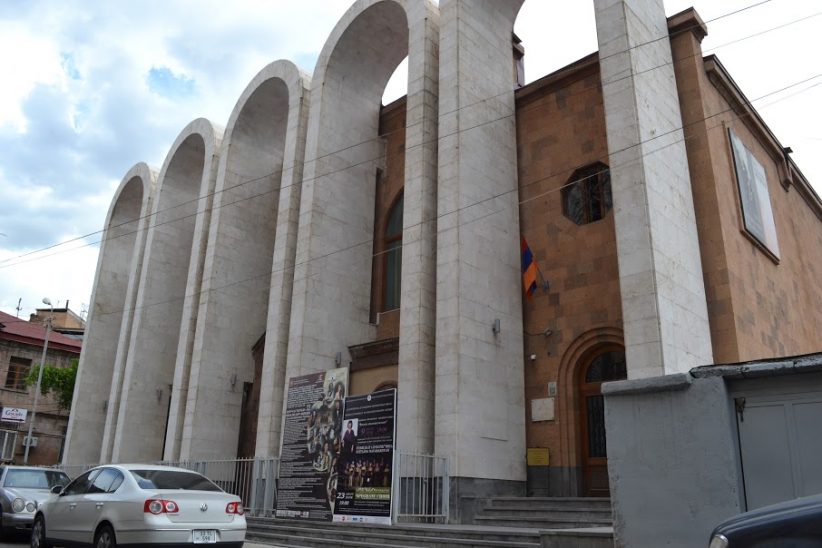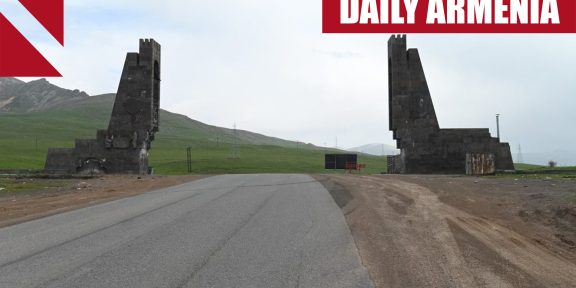ARAM KHACHATURIAN MUSEUM
 The Aram Khachaturian Trio performed at the museum concert hall on Sunday, 12 June, on behalf of the Aram Khachaturian International Competition. Violinist: Karen Shahgaldyan; Cellist: Karen Kocharyan; Pianist/Museum Director: Armine Grigoryan
The Aram Khachaturian Trio performed at the museum concert hall on Sunday, 12 June, on behalf of the Aram Khachaturian International Competition. Violinist: Karen Shahgaldyan; Cellist: Karen Kocharyan; Pianist/Museum Director: Armine Grigoryan
The Aram Khachaturian International Competition
The annual Aram Khachaturian International Competition concluded the conductor’s competition last night and announced June-Sung Park from South Korea / Germany and Miran Vaupotić from Croatia as this year’s winners.
The Aram Khachaturian International Competition was initiated as part of the composer’s 100th anniversary celebrations and is held annually since 2003. The competition draws participants from the CIS countries, U.S., Canada, Mexico, France, Germany, Spain, Italy, Belgium, Britain, China and other countries.
UNESCO has named Khachaturian as one of the greatest composers of the 20th century.
Here’s a story that Anahit Shahmanian, Collections Manager of the Aram Khachaturian House Museum, might tell on a tour of the museum: While in Italy, Aram Khachaturian decided to attend an opera. He was already world famous, but he didn’t want to make a spectacle of his attendance. He planned to attend quietly, but rumors spread. It was said that a great maestro would be present.
 Khachaturian and his wife Makarova appreciated fine clothes and perfumes. The museum holds several photographs of Khachaturian in the camel-colored coat.
Khachaturian and his wife Makarova appreciated fine clothes and perfumes. The museum holds several photographs of Khachaturian in the camel-colored coat.
As usual, Khachaturian was late and the opera already began, but the director noticed his arrival and informed the conductor. When the conductor heard that Khachaturian arrived, he stopped the orchestra and informed the audience that the great musician Aram Khachaturian was present. The people rose from their seats and cried. The next day, the newspapers said it was the only time in the history of Italian theater that an opera was interrupted to greet a musician.
There are many stories about the life of Aram Khachaturian to be discovered in the archives, posters, recordings, and from the staff of the Aram Khachaturian House Museum. For Armine Grigoryan, museum director and pianist for the Aram Khachaturian Trio, the stories that reveal a kind, benevolent heart where no request went unanswered, and the music that bares the emotional Armenian soul drew her to the Soviet composer who was born in Tbilisi and trained in Moscow.
A little about Khachaturian
In Moscow, Khachaturian studied European and Russian classical compositions, but his primary inspiration stemmed from the Armenian folk songs his mother sang when he was a child. According to Shahmanian, Khachaturian said his inspiration was the Armenian sun and sky. Yet, while he was preparing to write the “Spartacus” ballet score, he studiedItalian national music. It isn’t the same as ancient Roman music, Shahmanian said, butthere was some kind of connection, some kind of root to be traced.
The influence of musical traditions from around the world with a deeply-ingrained Armenian foundation created a distinct sound for Khachaturian. He created his own musical handwriting and advised his students to do the same.
The original house was given to Khachaturian who used it during his stays in Yerevan, but his mother, his brother and his brother’s family used it as their primary residence. As part of an agreement between Khachaturian and the Armenian government, the house would be converted into a museum.
 Khachaturian’s mother’s photograph sat on the piano in his Moscow work room, replicated here. A photograph of his second wife, Nina Makarova, hangs on the wall.
Khachaturian’s mother’s photograph sat on the piano in his Moscow work room, replicated here. A photograph of his second wife, Nina Makarova, hangs on the wall.
The museum itself is part household residence, part exhibit hall, and part concerthall. The house museum gives one insight into the private life of a Soviet public figure while the exhibit halls present documentation of his public achievements as an artist, a teacher, and as a socialist and Communist activist and Soviet cultural ambassador.
In spite of Khachaturian’s involvement and support of the Communist Party, none of these awards saved Khachaturian from Stalin who denounced and exiled Khachaturian for anti-populist, formalist compositions. Khachaturian was sent to Armenia and censored until he regained favor in December 1948 for his compositions for a documentary film about Vladimir Ilich Lenin.
The concert hall is also used regularly. Recently, the Aram Khachaturian International Competition hosted the Aram Khachaturian Trio who performed for the jury, participants, and public at the museum.
In addition, the museum houses an extensive library and archive collection available for scholarly research.
 Aram Khachaturian and Sophia Loren.
Aram Khachaturian and Sophia Loren.
Text and photos by Heather Momyer
ARAM KHACHATURIAN MUSEUM
ADDRESS: 3 Zarobyan Street
Yerevan, Armenia
HOURS: Mondays through Fridays: 11:00 AM to 4:30 PM
Saturdays: 11:00 AM to 4:00 PM
 Khachaturian was also fond of dolls and received many as gifts. As Collections Manager Anahit Shahmanian said, “talented people are a little extraordinary.”
Khachaturian was also fond of dolls and received many as gifts. As Collections Manager Anahit Shahmanian said, “talented people are a little extraordinary.”
GUIDED TOURS: In Armenian: 2,000 drams
In Russian, English, or French: 2,500 drams
WEBPAGE: http://akhachaturianmuseum.am
FACEBOOK: https://www.facebook.com/museum78/
















